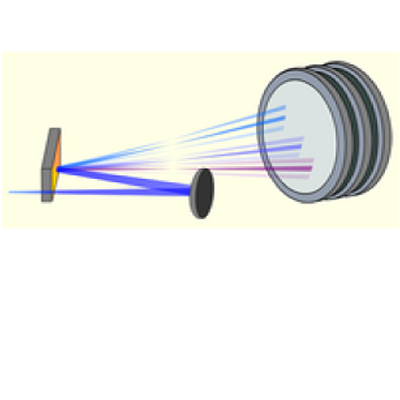Laser Science to Photonic Applications

The editors from Physical Review Letters, Physical Review X, Physical Review A, and Physical Review Applied have curated a short list of notable recent optics papers published in our journals. This compilation not only highlights research in our core publication areas, but also showcases select interdisciplinary and applied studies, illustrating the kind of submissions we encourage beyond the traditional or perceived scope of the Physical Review journals.
1 citation
Variance-based sensitivity analysis of -type quantum memory
Kai Shinbrough and Virginia O. Lorenz
Phys. Rev. A 107, 033703 (2023) – Published 3 March 2023
Editors' Suggestion 40 citations
Broadband Spintronic Terahertz Source with Peak Electric Fields Exceeding 1.5 MV/cm
R. Rouzegar, A.L. Chekhov, Y. Behovits, B.R. Serrano, M.A. Syskaki, C.H. Lambert, D. Engel, U. Martens, M. Münzenberg, M. Wolf, G. Jakob, M. Kläui, T.S. Seifert, and T. Kampfrath
Phys. Rev. Applied 19, 034018 (2023) – Published 6 March 2023

Spintronic terahertz emitters (STEs) are desirable broadband terahertz sources, but their limited signal strength has hindered practical application. By optimizing the photonic and thermal environment, the authors present an STE that could overcome this obstacle. Benchmarking against the state-of-the-art terahertz emitters based on optical rectification, this STE delivers strong terahertz pulses with comparable peak electric field and fluence, and offers additional features such as broadband radiation, easy alignment, and rotation of the terahertz polarization plane without power loss. This work will open up a promising pathway to nonlinear terahertz spectroscopy with spintronic sources.
Featured in Physics Editors' Suggestion 2 citations
Super Interferometric Range Resolution
John C. Howell, Andrew N. Jordan, Barbara Šoda, and Achim Kempf
Phys. Rev. Lett. 131, 053803 (2023) – Published 2 August 2023

A low-frequency radar method with improved resolution could aid in the detection of landmines and archeological objects.
Featured in Physics 17 citations
Broadband Quantum Enhancement of the LIGO Detectors with Frequency-Dependent Squeezing
D. Ganapathy et al. (LIGO O4 Detector Collaboration)
Phys. Rev. X 13, 041021 (2023) – Published 30 October 2023

The LIGO experiment has demonstrated a noise-squeezing technique for its entire frequency-detection range—a feat that could boost the detection rate of black hole mergers by up to 65%.
Featured in Physics 7 citations
Loss Compensation and Superresolution in Metamaterials with Excitations at Complex Frequencies
Seunghwi Kim, Yu-Gui Peng, Simon Yves, and Andrea Alù
Phys. Rev. X 13, 041024 (2023) – Published 3 November 2023

Illuminating a high-resolution lens with waves whose intensity diminishes over time can improve the image quality.
1 citation
Nonperturbative transverse mode coupling in high-order harmonic generation
Martin Luttmann, Mekha Vimal, Matthieu Guer, Titouan Gadeyne, Céline Chappuis, Jean-François Hergott, and Thierry Ruchon
Phys. Rev. A 108, 053509 (2023) – Published 16 November 2023
Featured in Physics 1 citation
Photon Pathways and the Nonperturbative Scaling Law of High Harmonic Generation
Mekha Vimal, Martin Luttmann, Titouan Gadeyne, Matthieu Guer, Romain Cazali, David Bresteau, Fabien Lepetit, Olivier Tcherbakoff, Jean-François Hergott, Thierry Auguste, and Thierry Ruchon
Phys. Rev. Lett. 131, 203402 (2023) – Published 16 November 2023

A new interpretation of high-harmonic generation—the cornerstone of attosecond physics—paves the way for quantum applications of this process.
Featured in Physics 2 citations
Photonic Flatband Resonances in Multiple Light Scattering
Thanh Xuan Hoang, Daniel Leykam, and Yuri Kivshar
Phys. Rev. Lett. 132, 043803 (2024) – Published 23 January 2024

Light–matter interactions in certain one-dimensional photonic materials can bring light nearly to a standstill, an effect that researchers show requires consideration of long-range interactions between the material’s components.
Editors' Suggestion 5 citations
Gate-tunable kinetic inductance parametric amplifier
Lukas Johannes Splitthoff, Jaap Joachim Wesdorp, Marta Pita-Vidal, Arno Bargerbos, Yu Liu, and Christian Kraglund Andersen
Phys. Rev. Applied 21, 014052 (2024) – Published 25 January 2024

Reading out the state of a quantum system at low temperature is generally challenging, as weak quantum signals must be amplified while adding as little noise as possible. Also, some qubit types rely on external magnetic fields and require magnetic-field-compatible superconducting parametric amplifiers. Here an innovative amp design leverages the nonlinear response of the gate-tunable kinetic inductance of proximitized semiconducting nanowires. The tunability allows integration with superconducting quantum systems, thanks to minimal crosstalk, and this amp can work with semiconductor-based spin qubits and other hybrid systems in magnetic fields of 500 mT.
Editors' Suggestion 1 citation
Quantum light-field microscopy for volumetric imaging with extreme depth of field
Yingwen Zhang, Duncan England, Antony Orth, Ebrahim Karimi, and Benjamin Sussman
Phys. Rev. Applied 21, 024029 (2024) – Published 14 February 2024

Light-field microscopy (LFM) extracts volumetric data from a specimen by simultaneously capturing the positional and angular information of light rays emanating from the sample. While conventional LFM requires a compromise between depth of field (DOF) and resolution, this work introduces a quantum approach to eliminate this compromise by harnessing position-momentum entanglement of photon pairs. Compared to conventional LFM at the same resolution, the quantum approach can yield up to tenfold improvement in DOF. This work illustrates the power of utilizing multidimensional entanglement in microscopy and hopefully will inspire further innovations in the field.
Featured in Physics 3 citations
Spatiotemporal Torquing of Light
S. W. Hancock, S. Zahedpour, A. Goffin, and H. M. Milchberg
Phys. Rev. X 14, 011031 (2024) – Published 28 February 2024

Researchers have determined the amount of transverse orbital angular momentum that a type of optical vortex carries per photon, an important step for future applications.
1 citation
Modeling and Predicting Second-Harmonic Generation from Protein Molecular Structure
Bahar Asadipour, Emmanuel Beaurepaire, Xingjian Zhang, Anatole Chessel, Pierre Mahou, Willy Supatto, Marie-Claire Schanne-Klein, and Chiara Stringari
Phys. Rev. X 14, 011038 (2024) – Published 6 March 2024

A new model refines an optical microscopy technique, allowing for micrometer-scale discrimination of key protein types and their organization in mammalian biological tissues.